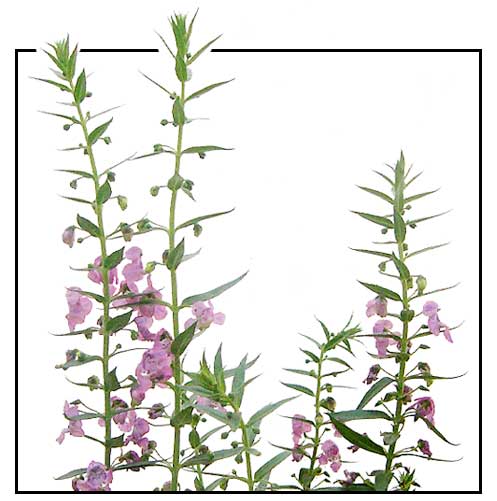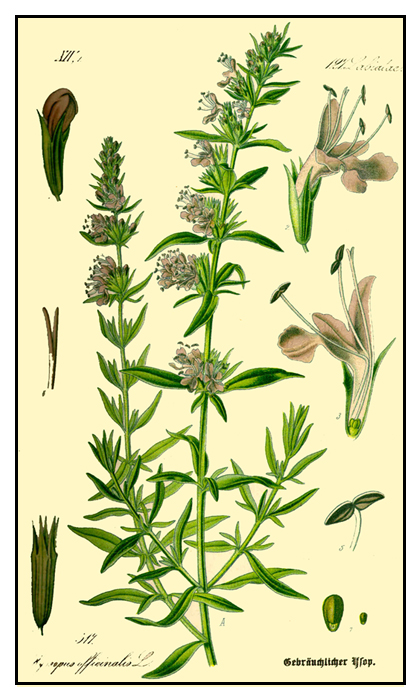Gen
info
Hyssops is a plant used since classical antiquity. Earliest reference to
the plant goes back to the seventh century. Its camphorlike odor found
utility as a cleansing herb; as an odor-eater it was strewn in sickrooms
and kitchen floors.

Botany
Hyssops is a strongly aromatic perennial
herbaceous plant belonging to the mint family, growing 30 to 60 centimeters or higher, upright and with many branched square
stems. Leaves are opposite, linear to lanceolate, hairless, long and
sessile, 1 to 1 1/2 inches long. Flowers are in whorls with a tubular
corolla, two-lipped, blue or violet in color, with bell-shaped calyxes.
 Distribution Distribution
- Cultivated as ornamental
and herbal plant.
- Occasionally grown as ground cover.
- Native to Southern Europe and temperate zones of Asia. In India, found in the Himalayas.
Constituents
- Plant yields several polyphenolic compounds, primarily the flavonoids apigenin, quercetin, diosmin, luteolin and their glucosides. Other phenolic compounds are chlorogenic, protocatechuic, ferulic, syringic, p-hydroxybenzoic acid and caffeic acids. (12)
- The aromatic volatile oil is found in its leaves, stems, and flowers.
- Essential oil analysis yielded the main components of cis-pinocamphone 42.9%, trans-pinocamphone 14.1%, germacrene-D-11-ol 5.7%, and elemol 5.6%.
(13)
- Study of aerial parts of H. officinalis yielded apigenin 7-O-ß-D-glucoronide as the major flavonoid. Essential oil yielded 20 compounds representing 99.97% of the oil, with main compounds of myrtenylacetate , camphor, germacrene, spathulenol. (see study below).
(16)
- Study of essential oil yielded compounds that corresponded to 97.2% to 98% of total oil content. Major compounds were cis-pinocamphonne (44.98%-50.77%), ß-pinene (13.38%-13.54%), trans-pinocamphone (5.73%-5.94%) and ß-phellandrene (4.44%-5.17%). (see study below) (22)
- Study of cell suspension cultures from callus of H. officinalis yielded two sterols i.e., ß-sitosterol and stigmasterol, together with pentacyclic triterpenes identified as oleanic acid, ursolic acid, 2a, 3ß-dihydroxyolean-12-en-28-oic acid and 2a,3ß,24-trihydroxyurs-12-en-28-oic acid. (23)
Properties
- Considered antiseptic, astringent, carminative, emmenagogue, expectorant,
purgative, stimulant, stomachic.
- Studies have suggested antibacterial, antifungal, antidiabetic, antioxidant, antiviral, ulceroprotective, antileishmanial properties.
Caution
- Shares a common name with
Artemisia vulgaris.
- Cross-allergenicity in those sensitive to plants in the Asteraceae/Compositae
family; ie, ragweed, chrysanthemums, marigolds and daisies.
- Warning has been made that volatile oil can cause convulsions. Avoid with epilepsy or fits. (5)
Parts utilized
- All aerial parts.
- Cut the stems before the flowers open, hang the bunches upside down
in a warm and dark place.
Uses
Culinary
- Leaves and flowers are
edible.
- It's minty leaves and flowers used as flavoring for salads, soups, and
poultry stuffing.
- Although too pungent for most palates, it has been used for herbal wines.
Folkloric
- Tincture and tea of the
flower used to cure jaundice and dropsy.
- Helps improve stomach tone.
- Crushed leaves or poultice of ground leaves promotes healing of wounds
and bruises.
- Hot vapors of its decoctions for inflammation of the ears.
- Infusion or decoction used for wound cleansing.
- Decoction of flowers used as expectorant.
- Used for liver and gall bladder complaints.
- As gargle and expectorant for colds and respiratory ailments.
- Infusion of leaves used externally for rheumatism. Also, as bath herb for rheumatism.
- Used to treat chest congestion, coughs; used as mild sedative.
- Used as gargle for sore throats.
- Used as poultice for bruises, sprains, wounds and insect bites.
- Used as a purgative.
- In China, used to relieve colds and asthma.
Others
- Baths: Flowers and leaves used
for herbal baths.
- Perfumes: Aromatic oil used in perfumes and potpourris.
- Bees, birds and butterflies are attracted to its flowers.
- Liquers: The volatile oil is a
key ingredient to some liqueurs. Its medicinal odor is notable in two liqueurs—Benedictine and Chartreuse.
- Ritual: Used for purgation (religious purification) in Egypt, where, according to Chaeremon of Alexandria, priests eat it with bread to purify the food making it suitable for their austere diet.
Studies
• Antifungal / Essential Oil:
In the study, the
essential oil of HO showed a very strong antifungal activity. The most
abundant components in oil are isopinocamphone (43%), pinocamphoe (16%)
and b-pinene (16%). The essential oil was fungistatic on Aspergillus
fumigatus. The strong antifungal potential of Hyssop essential oil can
be explained by the high amount of ketones, its main constituents. (1) Hyssop oil demonstrated antifungal activity against 52 clinical isolates and reference strains of Candida albicans, C. glabrata, C. tropicalis, C. paraapsilosis, and C. krusei. The essential oil inhibited both fluconazole-sensitive and fluconazole-resistant strains. (see constituents above) (22)
• Antimicrobial:
Study yielded pinocamphone and
isopinocamphone. All yeasts were strongly inhibited, seven strains of
C albicans, C krusei and C tropicalis. Limonene may be responsible for
the antimycotic action. (2)
• Diabetes
/ a-Glucosidase Inhibitory Activity / Leaves: Study
of aqueous methanol extracts of dried hyssop leaves showed (alpha)-glucosidase
inhibitory activity. (3)
• Phenolics
/ Rosmarinic Acid: Transformed
roots induced by infection with Agrobacterium rhizogenes produced high
levels of phenolic compounds such as rosmarinic acid and lithospermic
acid. B. (4)
• Antioxidant
/ Free Radical Scavenging Activity: In a study that established the antioxidant potency of of four medicinal and aromatic plants, H officinalis was second in DPPH-radical scavenging and first in reducing powers. (6)
• Antibacterial: In a study of the in vitro antimicrobial activity of three plant extracts including H officinalis against B subtilis, E coli, P aeruginosa, S typhimurium and S aureus, maximum antibacterial activity was exhibited by all three plant extracts, including P aeruginosa which was not inhibited by the control antibiotic. (7)
• Anti-Inflammatory / Antiasthmatic: Study evaluated the Uygur medicine H. officinalis on T-bet, GATA-3, STAT-3 mRNA levels of asthma rats to explore the mechanisms of its treatment effect in asthma. Results showed Hyssopus officinalis probably regulates the differentiation of Th1, Th2 and Th17 on transcription level for its anti-inflammatory effect. (11)
• Inhibition of Airway Inflammation / Immune Regulation: Study evaluated the effect of Hyssopus officinalis on airway immune regulation and airway inflammation in a mouse model of chronic asthma. Results showed H. officinalis not only plays an anti-inflammatory role by inhibiting the invasion of eosinophils and decreasing the levels of IgE, but also affects immune regulation. (14) Study evaluated the mechanism of Uygur herb H. officinalis in the process of airway remodeling. Results showed H. officinalis could inhibit airway remodeling by correcting imbalance of MMP-9/TIMP-1 ration. (21)
• Anti-Leishmanial: Study evaluated the alcoholic extracts of H. officinalis, Tussilage farfara, Carum copticum for in-vitro effects on Leishmania major. The plant extracts showed significant in vitro antileishmanial activities. (15)
• Phytochemical Analysis / Antioxidant: Study evaluated the flavonoid content of aerial parts of H. officinalis. Apigenin 7-O-ß-D-glucoronide was isolated as the major flavonoid. The N-butanol extract, because of the highest phenolic content had the best antioxidant activity. (see constituents above)
(16)
• Essential Oil of Aerial Parts / Antibacterial: Study of essential oil of aerial parts yielded thirty nine components, with major components of thymol 18,95%, ß-bisabolol 10.62%, carvacrol 7.73%, n-Dodecan (5.23%, caryophyllene 4.96%, ortho-acetanisol 4.72%, camphor 3.47%, cumin aldehyde 3.22% and spathulenol 3.02%. The oil showed high antibacterial activity against Erwinia amylovora and Klebsiella sp. (17)
• Ulceroprotective / Antioxidant: Pretreatment with an ethanol extract of Hyssopus officinalis in ethanol-induced gastric ulcer in rats showed significant ulceroprotective and antioxidant effect. (18)
• Muscle Relaxing Activity / Essential Oil: Study evaluated the muscle relaxing activity of essential oil of H. officinalis and some of its main components (isopinocamphone, limonene and beta-pinene) on isolated preparations of guinea-pig and rabbit intestine. EO and isopinocamphone inhibited acetylcholine- and BaCl2-induced contractions in guinea-pig ileum. EO blocked CaCl2 induced contractions in guinea pig ileum. (19)
• Effect on Airway Remodeling in Asthmatic Mice: Studies have shown HO can affect levels of cytokines in asthmatic mice. This study evaluated the mechanism of H. officinalis in the process of airway remodeling in asthmatic mice. Result showed HO could inhibit airway remodeling by inhibiting imbalance of MMP-9/TIMP-1 ratio. (20)
• Inhibition of HIV Replication: A 1990 study reported on the strong anti-HIV activity of crude extracts of dried leaves via inhibition of synciytia formation, HIV reverse transcriptase (RT), and p17 and p24 antigen expression. Study showed HO extracts contain caffeic acid, unidentified tannins, and possibly a third class of unidentified molecular weight compounds that exhibit strong anti-HIV activity. (24)
• Antiviral Polysaccharide: Study evaluated a polysaccharide (MAR-10) from the aqueous extract of HO for activity against HIV-1 (SF strain) in HUT78 T cell line. MAR-10 showed a concentration-dependent inhibition of HIV-1 replication via inhibition of HIV-1 p24 antigen and syncytia formation. (25)
Availability
- Cultivated.
- Wildcrafted.
- Hyssop essential oil, capsules and seeds in the cybermarket. |



 Distribution
Distribution

